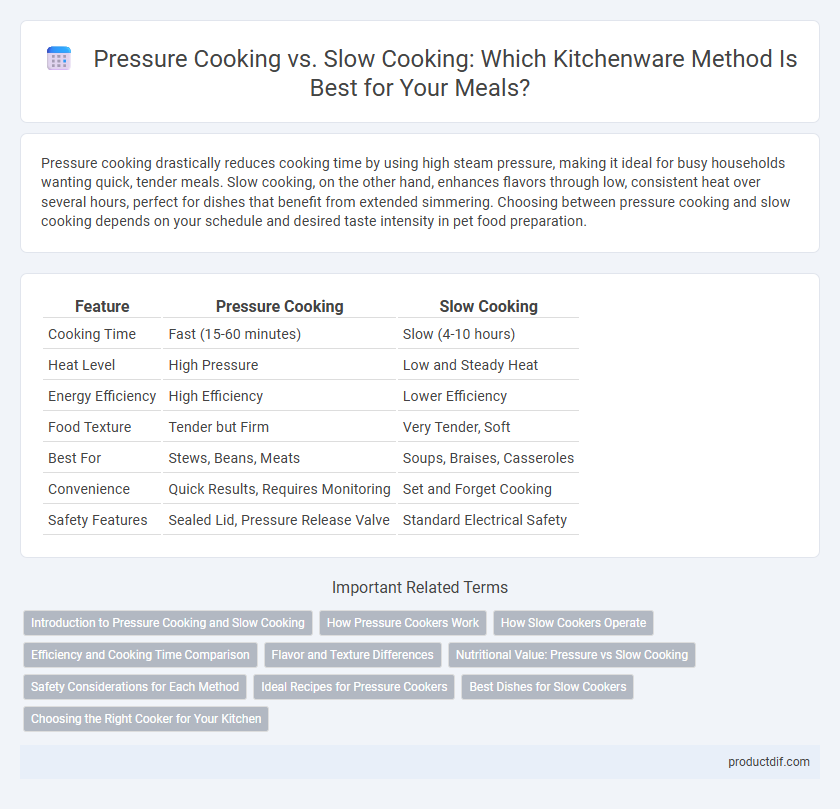Pressure cooking drastically reduces cooking time by using high steam pressure, making it ideal for busy households wanting quick, tender meals. Slow cooking, on the other hand, enhances flavors through low, consistent heat over several hours, perfect for dishes that benefit from extended simmering. Choosing between pressure cooking and slow cooking depends on your schedule and desired taste intensity in pet food preparation.
Table of Comparison
| Feature | Pressure Cooking | Slow Cooking |
|---|---|---|
| Cooking Time | Fast (15-60 minutes) | Slow (4-10 hours) |
| Heat Level | High Pressure | Low and Steady Heat |
| Energy Efficiency | High Efficiency | Lower Efficiency |
| Food Texture | Tender but Firm | Very Tender, Soft |
| Best For | Stews, Beans, Meats | Soups, Braises, Casseroles |
| Convenience | Quick Results, Requires Monitoring | Set and Forget Cooking |
| Safety Features | Sealed Lid, Pressure Release Valve | Standard Electrical Safety |
Introduction to Pressure Cooking and Slow Cooking
Pressure cooking uses high steam pressure to cook food quickly, preserving nutrients and enhancing flavor in less time. Slow cooking relies on low heat over several hours, ideal for tenderizing tough cuts and developing rich, complex flavors. Both methods offer distinct advantages for meal preparation, catering to different cooking needs and time constraints.
How Pressure Cookers Work
Pressure cookers use sealed pots that trap steam, increasing internal pressure and raising the boiling point of water, which cooks food faster by breaking down fibers and softening ingredients. This high-pressure environment significantly reduces cooking times compared to traditional methods, making it ideal for tougher cuts of meat and legumes. The controlled pressure and steam ensure even heat distribution, preserving nutrients and enhancing flavors.
How Slow Cookers Operate
Slow cookers operate by maintaining a consistent low temperature, typically between 170degF and 280degF, over an extended period, allowing flavors to meld and tough cuts of meat to become tender. Using a sealed pot with minimal moisture loss, slow cookers create a moist cooking environment that gently breaks down collagen and connective tissues. This method ensures energy efficiency and hands-off convenience, making it ideal for preparing stews, soups, and braised dishes.
Efficiency and Cooking Time Comparison
Pressure cooking significantly reduces cooking time by using high pressure to raise the boiling point of water, enabling meals to cook up to 70% faster than traditional methods. Slow cooking operates at low temperatures over several hours, which is energy-efficient for unattended cooking but less time-efficient overall. For busy households seeking fast meal preparation, pressure cookers offer superior efficiency, while slow cookers suit users prioritizing convenience and flavor development over speed.
Flavor and Texture Differences
Pressure cooking rapidly infuses flavors by using high heat and steam, resulting in tender meats and intensified seasoning absorption in a fraction of the time. Slow cooking enhances depth of flavor through prolonged simmering, allowing connective tissues to break down gradually and creating rich, melt-in-your-mouth textures. Both methods uniquely impact texture and flavor profiles, with pressure cooking favoring speed and preservation of vibrant tastes, while slow cooking delivers complexity and enhanced succulence.
Nutritional Value: Pressure vs Slow Cooking
Pressure cooking preserves more nutrients in vegetables and proteins by significantly reducing cooking time and exposure to heat compared to slow cooking. Slow cooking, while enhancing flavors and tenderness through prolonged heat, can lead to greater nutrient loss, especially water-soluble vitamins like vitamin C and B-complex. Both methods can retain essential nutrients if done properly, but pressure cooking offers superior nutrient retention due to its efficient cooking process.
Safety Considerations for Each Method
Pressure cooking features built-in safety mechanisms such as locking lids, pressure release valves, and gasket seals that prevent accidents from excessive pressure buildup. Slow cooking operates at lower temperatures over extended periods, reducing the risk of burns or explosions, but requires ensuring the appliance remains on a stable, heat-resistant surface to avoid fire hazards. Proper maintenance and regular inspection of seals, valves, and electrical components are essential for safe operation of both pressure cookers and slow cookers.
Ideal Recipes for Pressure Cookers
Pressure cookers excel with recipes that benefit from rapid tenderization, such as beef stews, chili, and bone-in chicken dishes, where high heat and pressure significantly reduce cooking time. Ideal recipes for pressure cookers include tough cuts of meat, legumes, and grains that typically require long simmering. These devices enhance flavors quickly while locking in moisture, making them perfect for dishes like braised short ribs or chickpea curry.
Best Dishes for Slow Cookers
Slow cookers excel at preparing hearty dishes like stews, chili, and pulled pork, where low and slow heat tenderizes tough cuts of meat and develops deep, rich flavors. Meals such as pot roast, braised short ribs, and vegetable soups benefit from the even, gentle cooking environment that enhances texture and melds spices thoroughly. This method is ideal for set-and-forget recipes that require minimal attention while maximizing taste and nutritional retention.
Choosing the Right Cooker for Your Kitchen
Pressure cooking uses high pressure and heat to cook food quickly, preserving nutrients and reducing cooking time by up to 70%, ideal for busy households. Slow cooking relies on low temperatures over several hours, enhancing flavors and tenderizing tough ingredients, perfect for meal prepping and hands-off cooking. Selecting the right cooker depends on your daily routine, desired cooking time, and recipe types to optimize kitchen efficiency and food quality.
Pressure Cooking vs Slow Cooking Infographic

 productdif.com
productdif.com